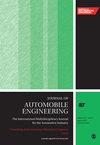Interactive decision-making for autonomous vehicles: A layered game-theoretic framework with situational awareness
IF 1.5
4区 工程技术
Q3 ENGINEERING, MECHANICAL
Proceedings of the Institution of Mechanical Engineers Part D-Journal of Automobile Engineering
Pub Date : 2024-07-23
DOI:10.1177/09544070241252480
引用次数: 0
Abstract
With the development of autonomous driving, future traffic will be composed of various participants. Integrating autonomous vehicles into the traffic flow composed of various types of traffic participants and minimizing conflicts between them is a critical research issue. Thus, this study presents a layered game-theoretic decision-making framework with situational awareness for autonomous vehicles, enabling adaptive decisions for autonomous vehicles in scenarios with multiple traffic participants of different driving characteristics. This paper’s situational awareness layer recognizes multiple participants’ politeness levels through their behavior and spatiotemporal relationships, allowing for a quantitative evaluation of their driving characteristics. The decision-making layer, built on Stackelberg game, adjusts the estimated cost of other traffic participants based on recognized politeness levels. The predictions of optimal behavior for traffic participants are obtained by minimizing the cost, according to which the optimal decision for the ego vehicle can be obtained. Besides, a set of parameters is used to construct the optimization problem as a convex optimization problem, so that the uniqueness of leader’s prediction of follower’s optimal action in each game can be guaranteed. To verify the feasibility and effectiveness, a trajectory planning layer for the autonomous vehicle is designed, the geometric safety constraint consists of planned trajectory and predicted trajectory of traffic participants are built to prevent collisions. Results indicate that the proposed framework can achieve balanced performance when interacting with traffic participants of different politeness levels.自动驾驶车辆的交互式决策:具有态势感知能力的分层博弈论框架
随着自动驾驶的发展,未来的交通将由各种参与者组成。如何将自动驾驶车辆融入由各类交通参与者组成的交通流中,并最大限度地减少它们之间的冲突,是一个至关重要的研究课题。因此,本研究提出了一个具有自动驾驶车辆态势感知功能的分层博弈论决策框架,使自动驾驶车辆能够在有多个不同驾驶特征的交通参与者的场景中做出自适应决策。本文的态势感知层通过多个参与者的行为和时空关系来识别他们的礼貌程度,从而对他们的驾驶特征进行量化评估。决策层建立在斯塔克尔伯格博弈的基础上,根据识别出的礼貌程度调整其他交通参与者的估计成本。通过最小化成本,可以预测交通参与者的最佳行为,并据此得出自我车辆的最佳决策。此外,利用一组参数将优化问题构造为凸优化问题,从而保证领导者在每次博弈中对跟随者最优行动的预测的唯一性。为了验证其可行性和有效性,设计了自动驾驶车辆的轨迹规划层,建立了由规划轨迹和交通参与者预测轨迹组成的几何安全约束,以防止碰撞。结果表明,在与不同礼貌程度的交通参与者互动时,所提出的框架可以达到平衡的性能。
本文章由计算机程序翻译,如有差异,请以英文原文为准。
求助全文
约1分钟内获得全文
求助全文
来源期刊

CiteScore
4.40
自引率
17.60%
发文量
263
审稿时长
3.5 months
期刊介绍:
The Journal of Automobile Engineering is an established, high quality multi-disciplinary journal which publishes the very best peer-reviewed science and engineering in the field.
 求助内容:
求助内容: 应助结果提醒方式:
应助结果提醒方式:


